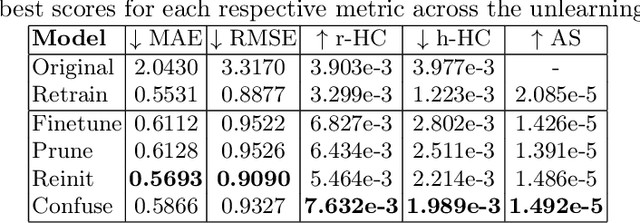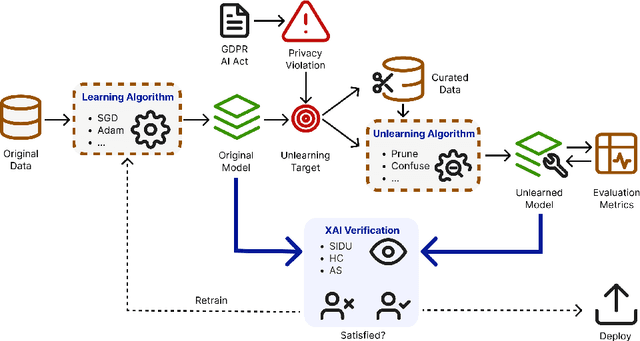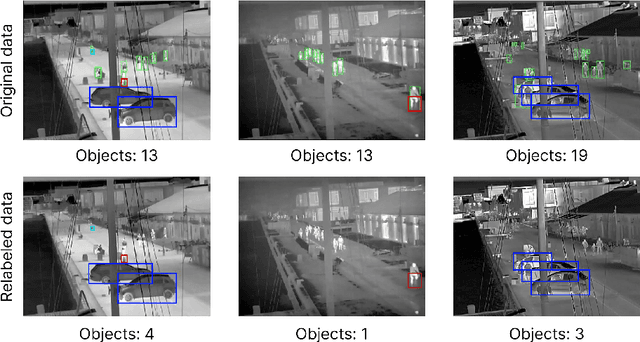Mohammad N. S. Jahromi
Verifying Machine Unlearning with Explainable AI
Nov 20, 2024



Abstract:We investigate the effectiveness of Explainable AI (XAI) in verifying Machine Unlearning (MU) within the context of harbor front monitoring, focusing on data privacy and regulatory compliance. With the increasing need to adhere to privacy legislation such as the General Data Protection Regulation (GDPR), traditional methods of retraining ML models for data deletions prove impractical due to their complexity and resource demands. MU offers a solution by enabling models to selectively forget specific learned patterns without full retraining. We explore various removal techniques, including data relabeling, and model perturbation. Then, we leverage attribution-based XAI to discuss the effects of unlearning on model performance. Our proof-of-concept introduces feature importance as an innovative verification step for MU, expanding beyond traditional metrics and demonstrating techniques' ability to reduce reliance on undesired patterns. Additionally, we propose two novel XAI-based metrics, Heatmap Coverage (HC) and Attention Shift (AS), to evaluate the effectiveness of these methods. This approach not only highlights how XAI can complement MU by providing effective verification, but also sets the stage for future research to enhance their joint integration.
SIDU-TXT: An XAI Algorithm for NLP with a Holistic Assessment Approach
Feb 05, 2024Abstract:Explainable AI (XAI) aids in deciphering 'black-box' models. While several methods have been proposed and evaluated primarily in the image domain, the exploration of explainability in the text domain remains a growing research area. In this paper, we delve into the applicability of XAI methods for the text domain. In this context, the 'Similarity Difference and Uniqueness' (SIDU) XAI method, recognized for its superior capability in localizing entire salient regions in image-based classification is extended to textual data. The extended method, SIDU-TXT, utilizes feature activation maps from 'black-box' models to generate heatmaps at a granular, word-based level, thereby providing explanations that highlight contextually significant textual elements crucial for model predictions. Given the absence of a unified standard for assessing XAI methods, this study applies a holistic three-tiered comprehensive evaluation framework: Functionally-Grounded, Human-Grounded and Application-Grounded, to assess the effectiveness of the proposed SIDU-TXT across various experiments. We find that, in sentiment analysis task of a movie review dataset, SIDU-TXT excels in both functionally and human-grounded evaluations, demonstrating superior performance through quantitative and qualitative analyses compared to benchmarks like Grad-CAM and LIME. In the application-grounded evaluation within the sensitive and complex legal domain of asylum decision-making, SIDU-TXT and Grad-CAM demonstrate comparable performances, each with its own set of strengths and weaknesses. However, both methods fall short of entirely fulfilling the sophisticated criteria of expert expectations, highlighting the imperative need for additional research in XAI methods suitable for such domains.
Learning-based Monocular 3D Reconstruction of Birds: A Contemporary Survey
Jul 10, 2022

Abstract:In nature, the collective behavior of animals, such as flying birds is dominated by the interactions between individuals of the same species. However, the study of such behavior among the bird species is a complex process that humans cannot perform using conventional visual observational techniques such as focal sampling in nature. For social animals such as birds, the mechanism of group formation can help ecologists understand the relationship between social cues and their visual characteristics over time (e.g., pose and shape). But, recovering the varying pose and shapes of flying birds is a highly challenging problem. A widely-adopted solution to tackle this bottleneck is to extract the pose and shape information from 2D image to 3D correspondence. Recent advances in 3D vision have led to a number of impressive works on the 3D shape and pose estimation, each with different pros and cons. To the best of our knowledge, this work is the first attempt to provide an overview of recent advances in 3D bird reconstruction based on monocular vision, give both computer vision and biology researchers an overview of existing approaches, and compare their characteristics.
Introducing and assessing the explainable AI (XAI)method: SIDU
Jan 26, 2021



Abstract:Explainable Artificial Intelligence (XAI) has in recent years become a well-suited framework to generate human understandable explanations of black box models. In this paper, we present a novel XAI visual explanation algorithm denoted SIDU that can effectively localize entire object regions responsible for prediction in a full extend. We analyze its robustness and effectiveness through various computational and human subject experiments. In particular, we assess the SIDU algorithm using three different types of evaluations (Application, Human and Functionally-Grounded) to demonstrate its superior performance. The robustness of SIDU is further studied in presence of adversarial attack on black box models to better understand its performance.
SIDU: Similarity Difference and Uniqueness Method for Explainable AI
Jun 04, 2020



Abstract:A new brand of technical artificial intelligence ( Explainable AI ) research has focused on trying to open up the 'black box' and provide some explainability. This paper presents a novel visual explanation method for deep learning networks in the form of a saliency map that can effectively localize entire object regions. In contrast to the current state-of-the art methods, the proposed method shows quite promising visual explanations that can gain greater trust of human expert. Both quantitative and qualitative evaluations are carried out on both general and clinical data sets to confirm the effectiveness of the proposed method.
 Add to Chrome
Add to Chrome Add to Firefox
Add to Firefox Add to Edge
Add to Edge